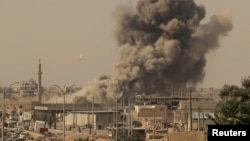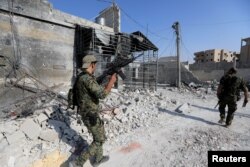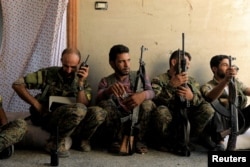As U.S.-backed forces continue to make slow progress in their offensive to oust Islamic State (IS) from its self-proclaimed capital of Raqqa, thousands of civilians who are trapped in the city face an increasing danger of getting caught in crossfire, rights organizations and local activists warn.
Officials from the U.S.-backed Syrian Democratic Forces (SDF) say their battle against IS has entered a fierce and grueling phase in the densely populated neighborhoods of the city, as the terrorist group tries various tactics to keep its stronghold.
"This fight has become a matter of life and death for both sides," Mustafa Bali, a spokesperson for the SDF, told VOA.
Bali said IS militants are increasingly using suicide car bombs, snipers, drones and tunnels to hinder SDF advances.
"But what distinguishes the operation for Raqqa from all other cities is the degree to which IS thugs use civilians as human shields," he said.
He added that IS has forced civilians to remain in their homes so coalition forces avoid airstrikes in those areas.
Despite IS tactics, the SDF was able to advance slightly from the southeast of the city, Bali said. As the forces marched forward, SDF's special units rescued nearly 250 civilians early Thursday.
Claims of civilians killed in airstrikes
Meanwhile, rights organizations and activists continue to express concerns about the rising death tolls among civilians in the besieged city.
Britain-based Syrian Observatory for Human Rights on Wednesday said an escalated shelling of Raqqa by the U.S.-led coalition warplanes since Monday has left nearly 60 residents dead, including 30 children and women.
The group said it expects the death toll to rise as recovery units continue to find missing bodies under the rubble.
Ryan Dillon, a spokesman for the U.S.-led coalition, told reporters on Wednesday that coalition jets have conducted more than 200 airstrikes against IS positions in Raqqa this week alone. He did not directly comment on the Syrian Observatory for Human Rights' findings.
Speaking with reporters during a phone briefing from Baghdad, Dillon talked about the stiff resistance the SDF forces are facing from about 2,500 IS fighters who still hold about 45 percent of the city.
He added that the jihadist group has centralized much of its operations and many of its fighters in densely populated areas and high-rise buildings, including the city's main hospital, in an effort to slow down the ongoing siege.
"They have fortified the complex, created tunnels for access, and are hiding among women and children who have nowhere else to go," Dillon said.
The United Nations estimates there are still nearly 25,000 civilians trapped inside the city. The agency has called upon the U.S.-led coalition and the SDF to increase their efforts to open safe corridors for the remaining civilians to flee.
"The worst place probably today in Syria is the part of Raqqa that is still held by the so-called Islamic state," Jan Egeland, the U.N.'s humanitarian adviser for Syria, told reporters on Thursday.
IS landmines
Hussam Eesa, a founder of the anti-IS monitoring group Raqqa is Being Slaughtered Silently, told VOA that many residents who escape airstrikes and IS snipers fall victim to the landmines planted by IS.
Eesa said about 350,000 residents have managed to escape the city, making it to nearby towns and villages under SDF control. But he said they continue to suffer from lack of basic services.
"The SDF areas are safer off course," Eesa said. "But there is a lack of aid and increased restriction on civilian movement in refugee camps."







